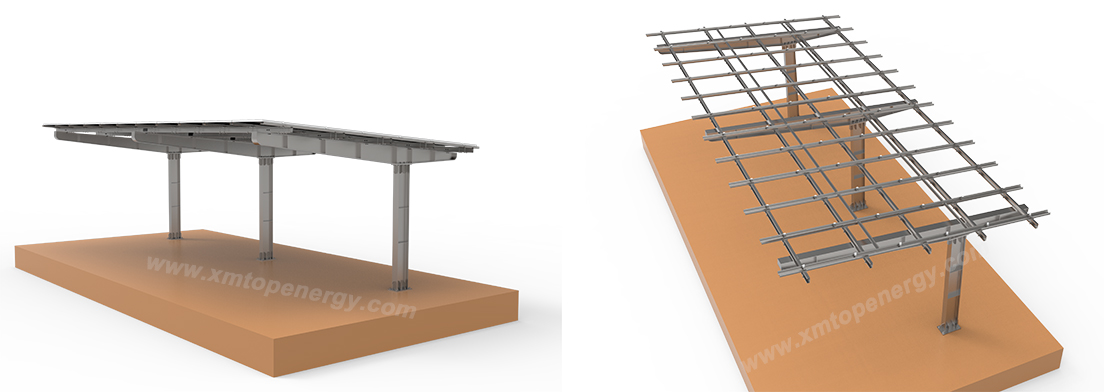In the quest for sustainable energy solutions, solar carports have emerged as a game-changing innovation. These structures, which combine the functionality of traditional carports with the energy-generating capabilities of solar panels, are transforming the way we think about renewable energy. By integrating solar technology into everyday infrastructure, solar carports are not only making renewable energy more accessible but also reshaping urban landscapes and energy consumption patterns.
Solar carports are elevated structures designed to provide shade and protection for vehicles while simultaneously generating electricity through photovoltaic (PV) panels installed on their roofs. Unlike ground-mounted solar arrays or rooftop solar installations, solar carports utilize underutilized spaces—such as parking lots—to produce clean energy. This dual-purpose design makes them an efficient and practical solution for both residential and commercial properties.

One of the most significant advantages of solar carports is their ability to make use of existing spaces. Parking lots, which are often vast expanses of unused real estate, can now serve as power-generating hubs. This is particularly valuable in urban areas, where land is scarce and expensive. By transforming parking areas into solar energy farms, solar carports are helping to maximize space efficiency without requiring additional land.
Solar carports contribute to the decentralization of energy production, a key trend in the renewable energy revolution. Instead of relying solely on large-scale power plants, energy can now be generated locally, closer to where it is consumed. This reduces transmission losses and enhances energy security, making communities more resilient to power outages and fluctuations in energy supply.
As the world shifts toward electric vehicles, the demand for accessible charging infrastructure is growing. Solar carports can be equipped with EV charging stations, allowing vehicles to be powered by clean, on-site solar energy. This not only reduces the carbon footprint of transportation but also makes EV ownership more convenient and sustainable.
By generating clean energy, solar carports help reduce reliance on fossil fuels, which are a major contributor to greenhouse gas emissions. A single solar carport can offset tons of CO2 emissions annually, making it a powerful tool in the fight against climate change. For businesses, installing solar carports is a tangible way to demonstrate their commitment to sustainability and corporate social responsibility.
Solar carports enable homeowners and businesses to generate their own electricity, reducing their dependence on utility companies. This energy independence is particularly valuable in regions with high electricity costs or unreliable power grids. Additionally, excess energy generated by solar carports can be stored in batteries or fed back into the grid, creating potential revenue streams through net metering programs.
Solar carports are being adopted in a variety of settings, showcasing their versatility and impact:
Commercial Parking Lots: Businesses are installing solar carports to power their operations, reduce energy costs, and provide shaded parking for employees and customers.
Residential Properties: Homeowners are using solar carports to generate electricity for their homes while protecting their vehicles from the elements.
Public Spaces: Airports, universities, and municipal facilities are leveraging solar carports to meet sustainability goals and provide clean energy to their communities.
While solar carports offer numerous benefits, there are some challenges to consider:
Initial Costs: The upfront investment for solar carports can be significant, although incentives, tax credits, and long-term energy savings often offset these costs.
Structural Requirements: Solar carports must be designed to withstand environmental factors such as wind, snow, and rain, which can increase engineering and material costs.
Site-Specific Design: Each installation requires careful planning to optimize solar panel orientation, tilt, and shading.
Despite these challenges, the long-term benefits of solar carports far outweigh the initial hurdles, making them a worthwhile investment for many property owners.
As technology advances and the demand for renewable energy grows, solar carports are expected to become even more efficient and affordable. Innovations such as bifacial solar panels, which capture sunlight on both sides, and integrated energy storage systems are poised to enhance the performance of solar carports. Additionally, as governments and organizations worldwide prioritize sustainability, the adoption of solar carports is likely to accelerate.
Solar carports are revolutionizing renewable energy by transforming underutilized spaces into power-generating assets. They offer a practical, scalable, and sustainable solution for reducing carbon footprints, supporting EV adoption, and enhancing energy independence. As the world continues to embrace clean energy, solar carports will play an increasingly important role in shaping a greener, more sustainable future. Whether for homes, businesses, or public spaces, solar carports are proving that the future of energy is not just above us—it’s also right where we park.

 Xiamen TopFence Co.,Ltd.
Xiamen TopFence Co.,Ltd. No. 77, LingXia South Road, Huli District, Xiamen City, Fujian, China
No. 77, LingXia South Road, Huli District, Xiamen City, Fujian, China Tel: +8613365923720
Tel: +8613365923720
 Email: info@xmtopfence.com
Email: info@xmtopfence.com
 IPv6 network supported Sitemap
| XML
| Blog
| Privacy Policy
IPv6 network supported Sitemap
| XML
| Blog
| Privacy Policy


